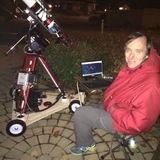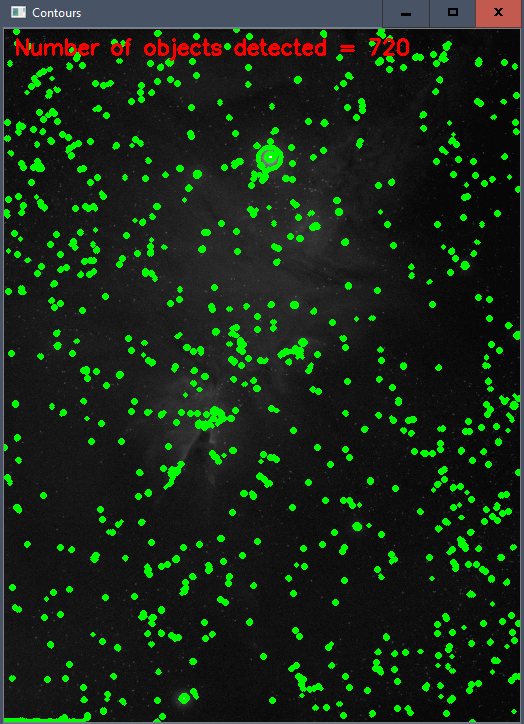INDI Library v2.0.7 is Released (01 Apr 2024)
Bi-monthly release with minor bug fixes and improvements
How to create a cloud sensor for a part of the sky?
Replied by GerardvS on topic How to create a cloud sensor for a part of the sky?
You triggered me to do some tests with OpenCV. There are plenty of "object count" examples available.
Thanks for the idea.
Please Log in or Create an account to join the conversation.
Replied by Porchet on topic How to create a cloud sensor for a part of the sky?
So unfortunately I'm terrible at programming.
Otherwise I'll try to do something about it.
That's why I'm asking if anyone has an idea how to do it or knows a way to do it.
And I'm not very good at English.
Please Log in or Create an account to join the conversation.
Replied by GerardvS on topic How to create a cloud sensor for a part of the sky?
I think it is fairly easy to either analyse the guider images or the real images and do a prediction of cloud coverage once the star-count has dropped significantly.
To be continued.....
Please Log in or Create an account to join the conversation.
- Gilles Gagnon
-

- Offline
- Elite Member
-

- Posts: 294
- Thank you received: 54
Replied by Gilles Gagnon on topic How to create a cloud sensor for a part of the sky?
What I am coming at is that a specialized/limited version of the Weather Radio could be built with a narrow FOV MLX90614 that would be put on the same axis and in from of the telescope tube. That could give you a good idea of the cloud cover in the FOV of the telescope, and the standard Weather Radio would give you an idea of the general cloud cover.
Ideally though, an all-sky (thermal?) camera with cloud detection/mapping over the KStars window would be preferred but... that's another story.
Please Log in or Create an account to join the conversation.
Replied by Porchet on topic How to create a cloud sensor for a part of the sky?
That's exactly what I thought of as an idea, so cool !!
The thing, now, it will be finished to integrate into kstars as we do for weather alerts.
But I think that on will have to add an additional camera, but that's not a problem, otherwise.
In all will I will wait impatiently to hear from you.
See you soon
Christophe
Please Log in or Create an account to join the conversation.
Replied by Porchet on topic How to create a cloud sensor for a part of the sky?
Please Log in or Create an account to join the conversation.
- Gilles Gagnon
-

- Offline
- Elite Member
-

- Posts: 294
- Thank you received: 54
Replied by Gilles Gagnon on topic How to create a cloud sensor for a part of the sky?
If you are interested/curious, you can look at the Melexis datasheet for the MLX90614, www.melexis.com/en/documents/documentati...s/datasheet-mlx90614 .
Please Log in or Create an account to join the conversation.
- Gilles Gagnon
-

- Offline
- Elite Member
-

- Posts: 294
- Thank you received: 54
Replied by Gilles Gagnon on topic How to create a cloud sensor for a part of the sky?
s3.cern.ch/inspire-prod-files-9/98f5d2c8...5cadd2963404c8ae5eec
Please Log in or Create an account to join the conversation.
Replied by Porchet on topic How to create a cloud sensor for a part of the sky?
So indeed it looks good, but I admit not having understood all because my English is not as good as before.
Does he put a simple all sky style camera or is it an IR camera?
So the most, it is if you manage to make a correspondence between what the camera detects and manage to say that in 10min it will be covered in kstars.
But I think it's more complicated to set up than a star-counting camera, right?
Please Log in or Create an account to join the conversation.
- Gilles Gagnon
-

- Offline
- Elite Member
-

- Posts: 294
- Thank you received: 54
Replied by Gilles Gagnon on topic How to create a cloud sensor for a part of the sky?
From what I get from the paper, a simple 1/0 detection/counting of stars (detected or not) will not take into account the possibility of light clouds through which some starlight could pass attenuated and be detected, leading to think that there are no clouds, thus giving a wrong estimation of the cloud cover. It may be interesting to evaluate the usefulness of coupling an all-sky camera star counting algorithm to a small FOV MLX90614 sensor to measure the "telescope pointed" sky temperature. You may still need to account for atmospheric effects and other factors but that's making for a more interesting/challenging project.
Please Log in or Create an account to join the conversation.
Replied by Porchet on topic How to create a cloud sensor for a part of the sky?
Whereas with a camera that always looks at the same place we should be more precise on the detection of clouds?
Please Log in or Create an account to join the conversation.
- Gilles Gagnon
-

- Offline
- Elite Member
-

- Posts: 294
- Thank you received: 54
Replied by Gilles Gagnon on topic How to create a cloud sensor for a part of the sky?
Anyway, that's all food for thought.
Please Log in or Create an account to join the conversation.


